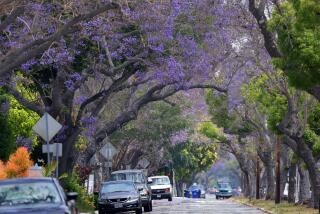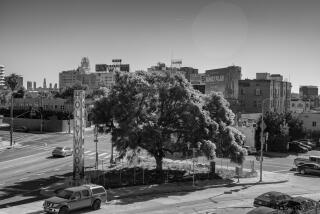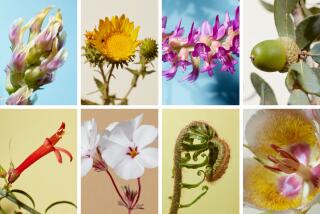A Jurassic park of their own
- Share via
BACK in the Jurassic period, long before the stegosaurus died out and last ice age had even begun, there was one great landmass called Pangea, and it was covered with an odd little tree called the cycad. The plant looked like your average palm but was anything but ordinary. Dinosaurs ate it, so it developed thorns and internal toxins. The landscape erupted with lava, so it evolved to have a subterranean trunk that withstood the fires raging on Earth.
Then humans came along. These days, poachers pluck this botanical relic from its habitats. Now 95% of the 300-plus species of cycads are threatened with extinction, despite international laws governing their harvest or trade. Cycads have become so rare, they are to plant collectors what a Zaha Hadid limited edition is to connoisseurs of contemporary furniture: almost priceless. Almost. Devotees buy and sell plants no larger than grapefruits for upward of $20,000. Prices rise exponentially for rare species with a few inches of trunk. Some Californians have collections so valuable they call upon cameras and guard dogs for protection. Yes, security just for the plants.
All of which is remarkable given that the demand for cycads stems primarily from their appeal as esoteric garden objets d’art. Sure, in some countries the toxic root of some species is sold as rat poison, and the sago palm -- technically not a palm at all but the most affordable species of cycad, Cycas revoluta -- is commonly used as a landscaping plant. But most types of cycads are hard to find, expensive, prone to rot and slow to grow, often taking decades to mature.
Therein lies part of the allure: Cycads are the ultimate in delayed gratification. They listen to the echo of epochs, not seasons. They have lived through fire, ice and, if you subscribe to certain hypotheses on the demise of the dinosaur, asteroids falling from the sky.
For those who wonder why anyone would put up with the extreme price and patience cycads demand, just wait for the flush of leaves. It’s a dramatic event that happens quickly, the bald crown transforming into a ring of leaves in six weeks. Collectors often use the same adjectives to describe what they see: Primeval. Prehistoric. Otherworldly.
Even more dramatic is when the plant declares its sex and the cones appear, male or female, erupting out of the crown. The cones can be massive, 80 pounds or more, and can produce hundreds of seeds after a year of growth. No matter that a few more years may pass before the seeds bother to send out a taproot.
Such is the pace of life when you’ve been around 280 million years.
WITH only two decades of collecting under his belt, Bob Burtscher would be considered a newbie in cycad circles if not for the fact that he apprenticed in the garden of Loran Whitelock, a local legend in study and collection of the elusive plant.
Burtscher was like a lot of cycad collectors when he first started. He wanted to get one of every species. He soon gave up on that dream, but still managed to develop one of Southern California’s finest collections, public or private. His mature specimens on a half-acre lot in Orange County are an assortment of the rare, the difficult and the bizarre.
“This is not a garden of evolution or development but rather of specimens, high-quality representatives of the best a species can produce,” says Burtscher, who, like many collectors interviewed for this story, asked that his exact location not be revealed because of the threat of theft. “This is a nice [Encephalartos] laevifolius. You don’t see those with 18 inches of trunk like that. There are two Microcycas from Cuba, they’re pretty rare. You’re not going to go over to Maurice’s and get one of those.”
Maurice is Maurice Levin of A&A; Cycads, a North Hollywood resource for local cycad growers primarily seeking seeds and seedlings.
Levin calls himself Johnny Cycad Seed and has made it his mission to give a cycad seed to any child who wants one. More than most plants, he says, cycads demand a long commitment -- owners with a future in front of them. Some collectors go so far as to see seedlings as investments that later will pay for their children’s college tuition.
Burtscher’s daughter is out of school, so he doesn’t need to worry about that. But if he did, he could go into his backyard, behind two fences and under the eye of security cameras and prowling dogs, and lop one of the “pups” off his fat-trunked Encephalartos woodii, a money tree if there ever was one.
It takes five years for the woodii to produce soccer-ball-size pups, knobby offshoots that can be separated and rooted for propagation. Most everyone in California’s cycad community seems to know that Burtscher’s pups are about to be struck off.
He won’t say how much he’s going to ask for them, but finding buyers won’t be hard. Though common sago palms sell for less than $50 at Home Depot, Burtscher’s specimens easily could fetch $15,000 to $20,000 each.
The woodii, the rarest of the cycads, is a special case. It was discovered at the turn of the 20th century in South Africa. Only a male plant was found, and it was moved to the Durban Botanic Gardens in 1905. Obtaining a woodii pup of your own is not impossible, just expensive. It’s a power plant, lending its owner bragging rights.
“It’s an interesting hobby,” Burtscher says laconically, surveying about 350 cycads mounded up along walkways and on hillocks. “Keeps you busy. Not a poor man’s hobby.”
SOUTHERN California’s serious cycad growers do tend to be wealthy, their circle imbued with the gravitas of a Victorian-era gentleman’s club, their unofficial membership composed of Phileas Fogg types drawn to a flowerless plant whose beauty is rooted in the subtleties of leaf symmetry, green-blue hues and a butch Paleozoic presence.
Dozens of local enthusiasts once socialized, traded plants and debated taxonomy. Then came the thefts.
“We’ve had 13 thefts of sizable cycads in the last four years,” says John Rees, a longtime enthusiast in Ventura County.
UCLA, private gardens in Orange County, Quail Botanical Gardens in north San Diego County, nurseries across the region -- they all have taken hits, he says. The thefts became so prevalent, the San Diego Police Department assigned an officer to a cycad beat.
“They’re expensive plants and easy to get out of the ground,” Rees says. “You just cut off the heads and the roots and take the trunk, the codex. If you have them under heat in a greenhouse, you can get roots out in six months and a salable plant in two years.”
Rees has collected cycads since the late 1950s -- about 70 varieties in all, primarily Mexican field study plants but also selections from Australia, Africa and Asia. His garden hasn’t been hit, but he knows people who have lost plants -- $50,000 worth in one incident.
“We had people looking in Florida and heard about a guy in the dope business who has a large garden behind walls with armed guards in Baja,” Rees says. “When those guys want something, they get it. It’s a collector mentality,” he adds, as though he were speaking of precious gemstones or an Edvard Munch painting.
As Rees walks around his yard, he points out plants that he’s held onto for decades: a feathery Macrozamia heteromera that has been the same size for 30 years, putting out a flush of leaves every five years or so. Nearby is a palm-like Macrozamia johnsonii that he got in the 1960s. “In 600 years it’ll be maybe 8 feet tall,” he says.
Off in the corner he points out the crowd pleaser, a foot-high, brilliant orange-red Encephalartos ferox cone that could stay on the plant for eight months.
“That stops everybody,” he says, “even people who aren’t into plants.”
DOWN the coast, in a canyon near Malibu, collector Leland Lai looks out to his mounds, where cycads have been planted in his own mix of sponge rock, bark and mulch. Though they can survive drought, Lai’s plants are watered by nine miles of drip hose arranged in 52 different watering zones.
Water drainage, like security, is a hot topic of discussion among growers. Cycads don’t like wet roots, especially when it’s cold. Most come from Southern Hemisphere locales where summers are warm and wet, and winters dry and cold.
“All my cycads are on mounds or created hills for positive drainage,” Lai says. “If I over-water on a hill, to get it established, it’s not going to rot.”
His light soil mix is designed to boost humidity and mimic the plant’s natural habitat. Sometimes nurturing a plant requires going to great lengths, but Lai says it’s all about protecting an investment. If you get a new plant with even the smallest of trunks, the established growth may represent 10 years’ worth of development.
“You’re buying time,” Lai says.
That’s what can make theft all the more aggravating. Cycads, which live up to 1,500 years, can be like a rare antiquity -- unique, historic and, if stolen, virtually impossible to sell on the open market.
“It’s a very small community,” Lai says. “I had gotten hold of a pretty small codex and within two days someone from Florida was calling, saying ‘Are you interested in selling? I’d double your money,’ without even knowing what I’d paid for it.”
He blames the rash of thefts on new collectors who have more money than patience and who, perhaps unwittingly, drive up the value of rare species. Brad Pitt, Oprah Winfrey, David Bowie and Kevin Costner are among the celebrities that cycad sellers and published reports cite as collectors.
FURTHER reducing supply is a new South African law that goes into effect June 1. It will limit cycad sales to specimens that are about 6 inches or smaller in girth. Certain species will be banned from trade, even as seedlings, and all nurseries will have to prove the source of their seeds. South Africa already exports plants with microchips in an attempt to reduce poaching.
Cycads are indigenous to five continents, so fighting poachers in the plants’ natural habitats can seem like a lost cause. Given the prices some rare species command, it’s no wonder thieves lust to rip them out of the wild, says Levin, North Hollywood’s Johnny Cycad Seed.
It’s a global concern, but Levin sees the solution in local distribution. Make the plant widely available in garden centers, at lower prices, and poachers no longer will have an incentive to steal, he says.
As Levin walks through his seed rooms, he pauses, softly handling golf-ball-size seeds resting naked on top of a tray of heated perlite. He picks one up and gently rotates the orb so that the root end will be closer to the perlite.
“On a big cone there are 500 seeds, and if a plant has two cones there might be 1,000 seeds,” he says. “Imagine there are only 20,000 of these plants left. If you can fertilize the cones of one plant you can increase the number of the species by 5%. With one plant.”
He repeats his mantra: Propagate, pollinate. “Get so much material out there,” he says, “that the economic motivation to pull it out of the wild is gone.”
*
(BEGIN TEXT OF INFOBOX)
Beginner’s guide to the rare plant
Ten tidbits that cycad experts say every novice should know:
First cycad: A good starter seedling for novices is Encephalartos altensteinii, which might cone in as few as eight years. Produces up to three flushes of foliage a year.
Hot species: Encephalartos woodii, which has no known female specimens on Earth. Clones of male plants sell for $15,000 to $20,000 each, depending on size.
Prime theft target: Encephalartos horridus, so named because of how you feel when you back into its spines. Sought for its delicate blue color. $350 to $700, depending on size. Often bought in groups of 10 to 20 for landscaping.
Planting: Maurice Levin of A&A; Cycads in North Hollywood likes to plant with a succulent mix that’s three-quarters pumice, sand and perlite, and one-quarter organic material. Use a lot of pumice at the bottom for drainage. “Water and cycad roots should be like ships passing in the night,” he says.
Feeding: Some growers insist cycads thrive on neglect. Others fertilize plants two or three times a year. Collector Bob Burtscher keeps his cycads on a steady, low fertilizer injector system year-round.
Watering: Burtscher waters the first day of a heat wave and twice a week when the heat is in the high 80s and 90s. He says to “watch the ground cover” and when it starts to wilt, water. Drainage is everything.
The trunk: Don’t expose it. Retail nurseries like the trunk to show, but it’s not good for the plant. Cycads reveal their trunk when they’re ready.
Book for beginners: “The Cycads” by Loran M. Whitelock, published by Timber Press in 2002. Comprehensive, with beautiful photography.
Website: www.plantapalm.com/vce/vce_index.htm is a virtual encyclopedia with tips, taxonomy, regulations, personal stories, conservation information and links.
Preventing theft: Collectors employ pretty much everything: gates, fences, lights, cameras and dogs. No plant labels.
-- Jeff Spurrier


